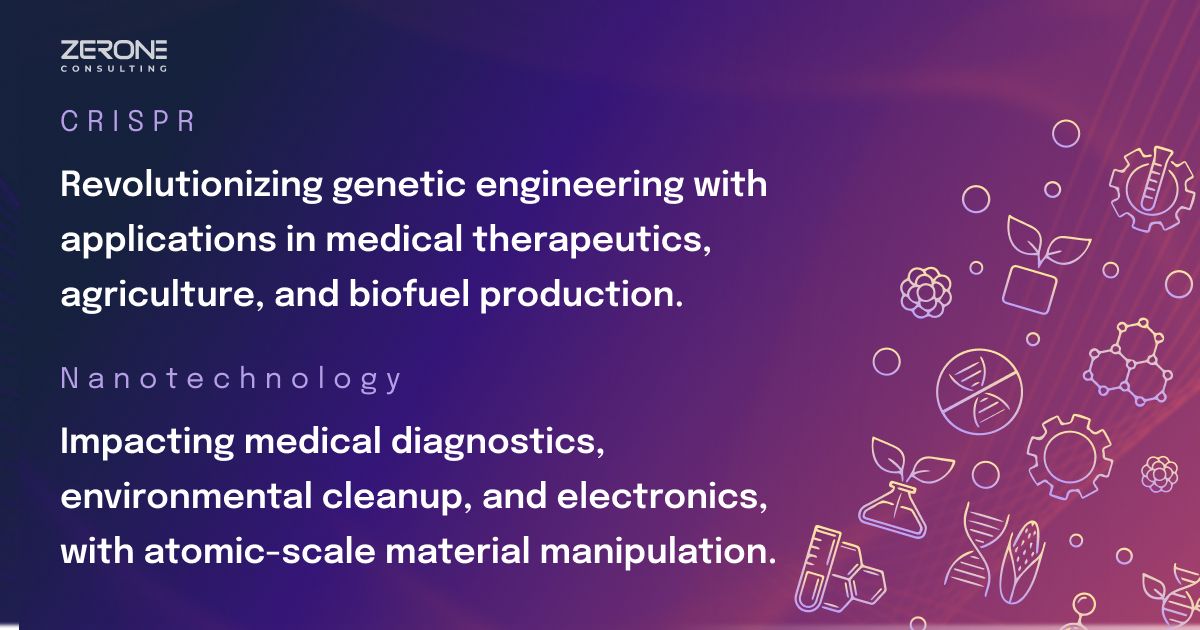Editing Nature: The Revolutionary Implications of CRISPR and Nanotechnology
As we stand on the brink of a technological renaissance, CRISPR (Clustered Regularly Interspaced Short Palindromic Repeats) and Nanotechnology are not just transforming the biological and physical sciences but are also seamlessly integrating with the realms of computing and Artificial Intelligence (AI). This integration is paving the way for smarter, more efficient, and highly personalized solutions across various sectors.

CRISPR: The Gene-Editing Powerhouse
CRISPR technology is a testament to human ingenuity, allowing precise modifications to DNA. Its application ranges from correcting genetic defects to enhancing crop resilience, all with unprecedented accuracy and efficiency.

Real-World Applications of CRISPR
-
Medical Therapeutics: By pairing CRISPR with AI-driven predictive models, scientists are not only treating genetic disorders but also anticipating potential complications, leading to more effective and customized treatments.
-
Agricultural Modifications: AI algorithms optimize CRISPR gene editing to develop crops that are more nutritious, resilient, and suited to specific climatic conditions, revolutionizing food sustainability.
-
Biofuel Production: Through CRISPR and AI, the process of biofuel production is being refined and scaled, leading to more viable and environmentally friendly energy alternatives.
Nanotechnology: Engineering at an Atomic Scale
Nanotechnology's ability to manipulate matter at the minutest scale is enabling breakthroughs that were once the realm of science fiction, from targeted drug delivery systems to new materials that redefine our material world.
Notable Applications of Nanotechnology
-
Medical Diagnostics and Treatment: Nanotechnology, when combined with AI, is enhancing the precision of diagnostics and therapeutics, particularly in oncology, by accurately targeting cancer cells while preserving healthy ones.
-
Environmental Cleanup: AI models optimize the deployment of nanomaterials in environmental cleanup, effectively removing pollutants and rehabilitating ecosystems with minimal human intervention.
-
Electronics: Nanotechnology is integral to the next generation of computing, including the development of quantum computers and ultra-efficient storage devices, with AI accelerating design and testing.
Bridging with Computing and AI
The convergence of CRISPR, Nanotechnology, and AI is not merely additive but multiplicative in its impact. AI's predictive power and advanced algorithms enhance the precision and effectiveness of CRISPR and Nanotechnology, leading to:
-
Smart Therapeutics: AI's real-time data analysis and adaptive learning are equipping CRISPR and Nanotechnology with the ability to not just react but predict and personalize medical treatment, creating a new era of smart therapeutics.
-
Agricultural and Energy Innovations: AI is revolutionizing how we engineer crops and biofuels, leading to more resilient agricultural systems and sustainable energy solutions.
-
Advanced Diagnostics and Treatment: By integrating patient data, AI is revolutionizing how diseases are diagnosed and treated, making healthcare more predictive, personalized, and preemptive.
Conclusion
The fusion of CRISPR, Nanotechnology, and AI signifies an exciting journey ahead, filled with profound transformations in how we live, work, and solve the world's most pressing challenges. As these technologies evolve, they promise not only groundbreaking applications but also raise important questions about ethics, governance, and the future we wish to create. It is a collective journey, and staying informed and engaged is key to navigating this promising yet uncharted territory.
We can help!
Why Scrum Fits Like A Glove
#Customapplicationdevelopment
Mvps - A Silver Bullet In Software Development
#Customapplicationdevelopment



